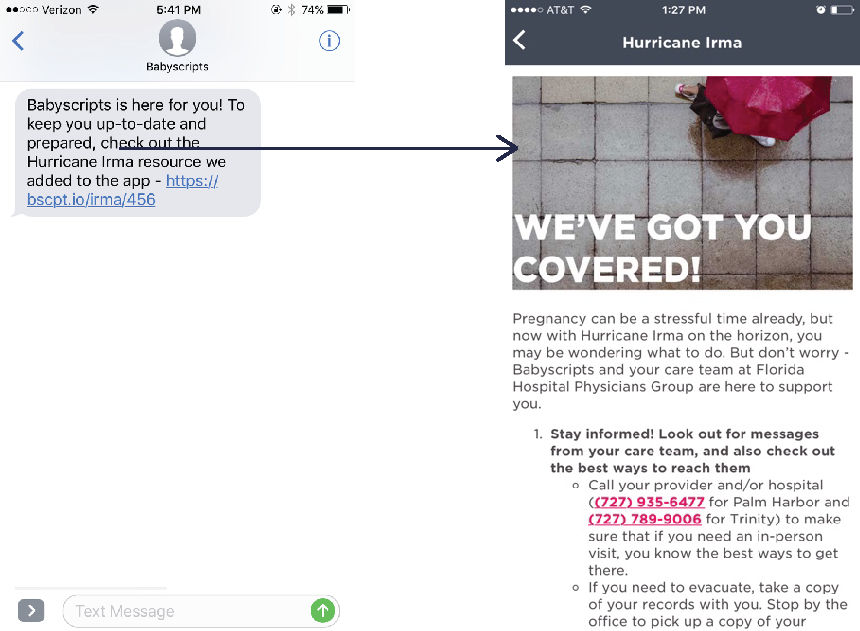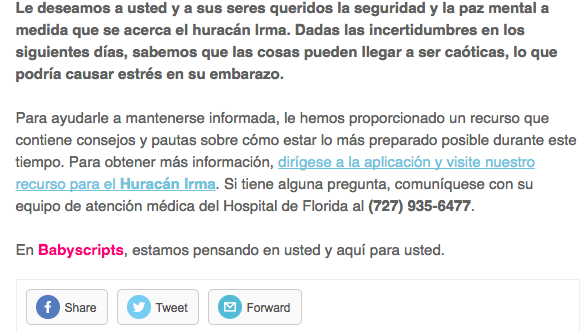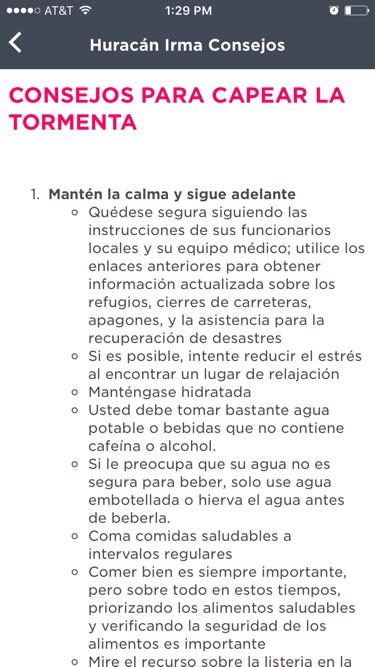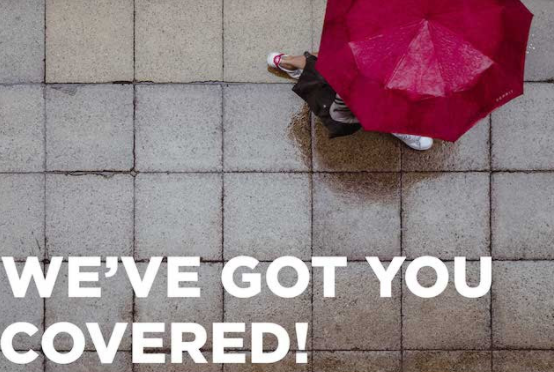Your blog post
During this hurricane season, our country has grappled with historically powerful hurricanes hitting the Gulf Coast and Eastern seaboard. Babyscripts knows that pregnant patients are even more vulnerable to the after-effects of natural disasters. Last week, we described our real-time approach to push out useful information to our users, and used data analytics to assess what kind of value we delivered when Hurricane Harvey hit the city of Houston.
We had barely scratched the surface of our lessons learned from that effort when Hurricane Irma started to advance towards the coast of Florida.
However, we did find remarkable results, which showed us unprecedented levels of engagement with the material we provided, that told us that more patients would benefit from our new, event-based approach. Now that we know it works, the question is: how do we deliver even more value to our patients, and help them receive even better care — and how do we figure this out fast, to help patients all the way from Florida to South Carolina?
In particular, we believe that the real-time nature of our platform meets this need — but perhaps there were different ways to conduct our outreach and potentially get even more patient engagement.
What We Did
As we did before, the process started by having our team create a resource specific to each of our clients. Our medical and product teams reviewed the content, updated it with relevant information for Irma, and uploaded it to the mobile app. “Hurricane Irma — Readiness Tips” contains information on the following:

- How to stay informed and connected to your health care team
- How to identify signs of preterm birth
- How to stay up-to-date on local and statewide news regarding safety, transportation, and other areas of concern
- Tips on how to weather the storm, especially while pregnant!
As we mentioned in our last post, while we provide a baseline of information in this resource, our clients also have the ability to update information for all of our resources, including Irma, in real time, through our patient and content management portal, DIANA (the Data Insights and Navigation App).
How We Did It:
With Hurricane Harvey, we used push notifications and e-mails to engage patients — you can read a bit more about it here. This time with Irma, we decided to test the efficacy of text messages instead of push notifications.
What was different this time:
Use of ‘Deep-linking’: One of our priorities was directing the patient to the resource as quickly as possible. To accomplish this goal, we inserted a deep-link into our e-mails and text messages. When a user taps a deep-link, it not only takes her directly into the app, it points her directly to the specific resource we would like her to utilize. Deep-links are used to engage patients in a more meaningful way, driving value for our users by getting them information quicker and more efficiently.

Not Just English: Not all of our moms are English-speaking, especially in areas of South Florida. It was essential that we were able to reach out Spanish patients, so we translated our content and added it to DIANA. Because of the configuration of our app, we could be sure that patients received the appropriate version of their resource once they clicked the deep link.

Spanish — Email

Use of more visuals: Intuitively, we know that visuals can create more engagement and connection, so we added a base image into the resource to create some balance between visual appeal and information.

What Happened:
Hurricane Irma impacted our patients in Florida and South Carolina. In the 30 days prior to our campaign, we observed an average of four sessions per day. In the week after the campaign was launched, we’ve had almost 200 app launches, with the average number of sessions per day increasing 150%!
What’s Next:
Our team is constantly iterating on our suite of products based on client feedback and our own internal analytics. Based on what we learned this time, here is what we would like to try next time around:
- Timing is key — We launched our campaign the day before Hurricane Irma made landfall in Florida, during a time where patients were likely scrambling to get prepare for the impending storm. We think that reaching out a bit earlier, when patients have more time to engage with the app and plan, will lead to greater engagement.
- Additional segmentation is needed to further drive value for our patients. This includes considering an omni-channel approach in engagement:
- E-mail and Push Notification — Does this meet our goal of driving patients to a particular resource? If not, we’ll follow up with:
- Text Message — Does this meet our goal? If not,
- Combination of E-mail, Push Notification and Text Message — Out of the three channels we employed, which ones did patients NOT access? Depending on the circumstances, is another message warranted?
- Phone Call — In rare circumstances, a phone call may be warranted to ensure that patients are kept up-to-date.
content here…

Submit a comment